Last Updated on December 9, 2024 by Owen McGab Enaohwo
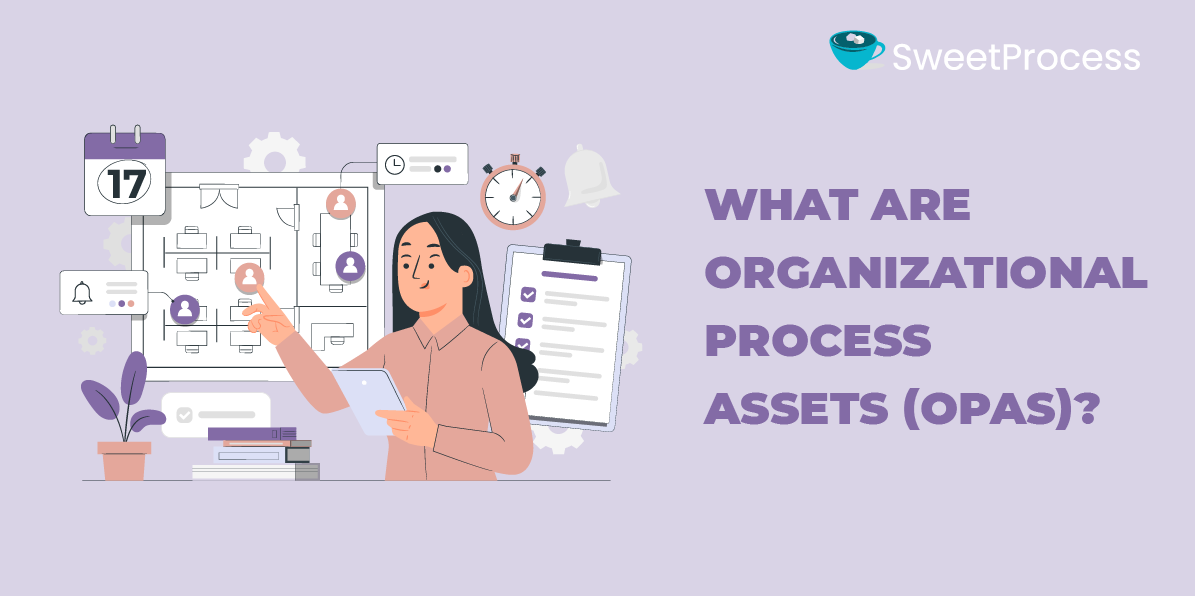
Imagine you run a company where every project, task, and decision seems to operate in isolation without a cohesive framework. Your teams work in silos, which means crucial information is not distributed to everyone. In such a disorganized setting, deadlines become elusive, and the company needs to work on evolving with the rapidly changing market demands.
A company needs well-structured organizational process assets to avoid chaos and jeopardize the survival of a business. However, you can avoid all this by implementing organizational process assets like knowledge bases to guide your team efficiently.
This article will delve into the significance of organizational process assets and explore how to develop and manage them effectively for better workflows.
Take the first step toward organizational excellence. Sign up for a 14-day free trial of SweetProcess today—no credit card is needed!
Table of Contents
What Are Organizational Process Assets (OPAs)?
Benefits of Organizational Process Assets in a Company
Categories of Organizational Process Assets (Plus Examples)
Procedures: Building the Foundation for Your Organizational Process Assets
Processes: Leveraging Existing Procedures to Create OPAs That Stand the Test of Time
Policies: Keeping Everyone on the Same Page Regarding Your Organizational Process Assets
Knowledge Bases: Educating Team Members on an Ongoing Basis
Best Practices for Managing Your Company’s Organizational Process Assets Effectively
Organizational Process Assets (OPA) vs. Enterprise Environmental Factors (EEF): How They Differ
Document and Manage Your Organizational Process Assets (OPAs) Using SweetProcess
What Are Organizational Process Assets (OPAs)?
Organizational process assets (OPAs) are the collective knowledge and documented processes that an organization accumulates and utilizes to enhance its efficiency, performance, and decision-making capabilities. Think of OPAs as the institutional memory of a company from lessons learned, best practices, and historical data.
These assets include policies and procedures, plus templates for past project documentation, performance records, and organizational culture. Most organizations use this toolkit to empower teams and navigate through opportunities with a well-informed approach.
Just as a seasoned chef relies on a curated collection of recipes, techniques, and ingredients to create a masterpiece, an organization leverages OPAs to craft successful strategies, streamline workflows, and learn from past triumphs and setbacks.
You should know that OPAs are unique to every organization. Therefore, a car-selling business will have different OPAs than a digital marketing agency because they operate in different environments. This is because the procedures and processes are custom for each company.
Here are some examples of OPAs:
● Risk templates
● Standardized guidelines
● Organizational standard processes
● Proposal evaluation criteria
● Project closure guidelines
● Work breakdown structure templates
● Project files
● Project schedule network diagram templates
● Lessons learned and historical databases
● Process measurement databases
● Change control procedures
● Financial control procedures
● Historical records of projects
Benefits of Organizational Process Assets in a Company
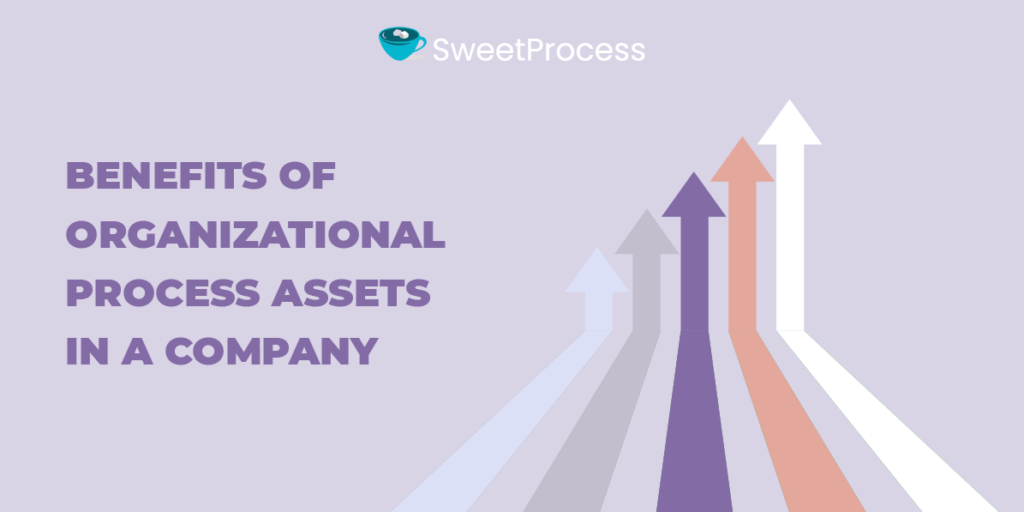
If you want to design an efficient organizational system for your business, you must have the proper OPAs in place. Here are the benefits you get from using these assets:
1. Aids Knowledge Transfer
OPAs facilitate seamless knowledge transfer within a company. For instance, when a key team member with specialized expertise suddenly departs, there could be a knowledge gap. However, if the organization has a well-documented repository of processes, procedures, and lessons learned, the transition becomes significantly smoother.
New team members can refer to these assets to quickly grasp the details of ongoing projects. This approach ensures a continuous flow of knowledge and minimizes disruptions.
2. Proactive Risk Management
Your business needs these assets as a shield against potential pitfalls by providing a structured approach to risk management. For instance, a company with a comprehensive risk database can identify patterns from past projects, anticipate challenges, and implement mitigation strategies.
This foresight empowers the organization to navigate uncertainties with greater agility. In addition, you can prevent costly setbacks and foster a culture of proactive risk management.
3. Promotes Compliance and Governance
OPAs are invaluable for ensuring compliance and governance in industries with stringent regulations. By maintaining a repository of established processes aligned with industry standards, your organization can effortlessly demonstrate adherence to regulations during audits. This safeguards the organization from legal ramifications and enhances its reputation as a trustworthy business.
4. Provides a Repository of Historical Information
The historical repository aspect of OPAs comes in handy for most organizations. For example, by examining the outcomes of past projects stored in the organizational archives, teams can identify successful strategies, learn from mistakes, and continually refine their approaches.
This historical perspective steers the company toward more informed decision-making and continuous improvement.
5. Enables Benchmarking Against Industry Guidelines
Companies can use OPAs to benchmark their practices against industry guidelines and standards. For instance, if you run a manufacturing company, you can compare its production processes with industry best practices, identifying areas for improvement and innovation. This benchmarking fosters competitiveness and positions the organization as a leader in its sector by staying abreast of industry trends and advancements.
Categories of Organizational Process Assets (Plus Examples)
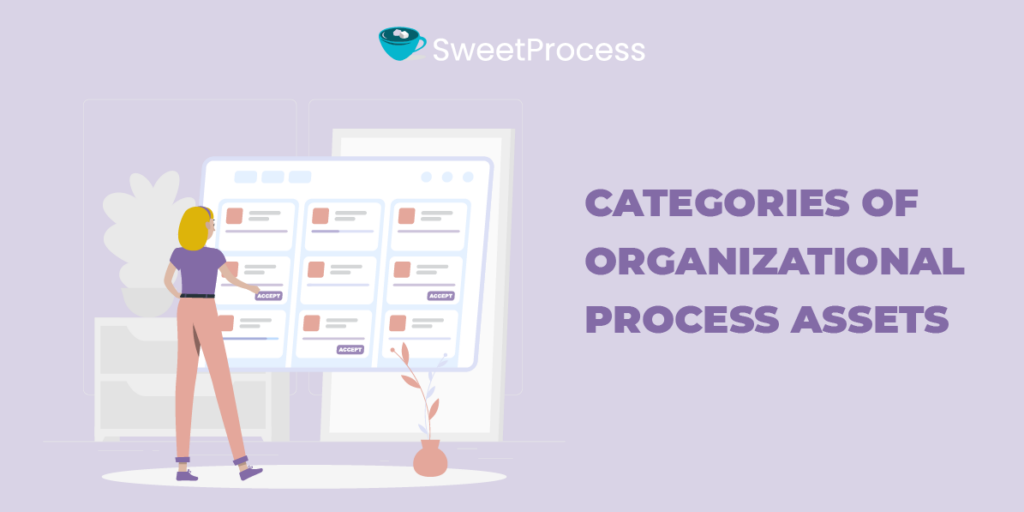
If you want to develop organizational process assets, here are the different categories and examples.
1. Procedures, Processes, and Policies
Procedures, processes, and policies are fundamental components of organizational process assets that provide a structured framework for executing, managing, and governing work.
These elements establish a blueprint for day-to-day operations, fostering consistency, efficiency, and compliance with organizational standards. While clear procedures outline the step-by-step actions required for specific tasks, processes define the broader workflows connecting various activities. On the other hand, policies set guidelines for decision-making and organizational behavior.
Here are some good examples:
Guidelines
Guidelines are recommendations or principles that guide decision-making and actions within the company. They provide a framework for best practices and preferred approaches. For instance, your company can have communication guidelines that outline preferred modes of communication, response times, and etiquette to ensure effective and respectful interactions within the organization.
SOPs
Standard operating procedures (SOPs) are detailed step-by-step instructions that describe how routine tasks or activities should be carried out within an organization. SOPs ensure consistency, compliance, and efficiency in day-to-day operations. For instance, your company can have a quality control SOP that prescribes standardized methods and criteria for ensuring the quality of products or services.
Templates
You can use templates to develop your OPAs faster and more efficiently. These pre-designed documents or formats provide a starting point for creating consistent and standardized deliverables. Additionally, these tools streamline processes, reduce errors, and maintain a cohesive organizational identity.
A good example is a project plan template that offers a structured framework for outlining project objectives, timelines, milestones, and resource allocation to ensure a consistent approach to the plan.
Contract Agreements
If you work with external parties, you need contract agreements. These legal documents define the terms, conditions, and expectations of agreements between the two parties. For instance, your organization could have a service level agreement (SLA) detailing the agreed-upon service levels, response times, and responsibilities between the organization and a service provider.
These documents promote clarity and mitigate risks associated with business transactions.
Project Life Cycle
The project life cycle within OPAs refers to the phases or stages a project progresses through, from initiation to closure. It provides a structured approach to project management so that projects are planned, executed, and closed systematically.
For instance, you can divide your company project into phases like initiation, planning, execution, monitoring, and closure. This approach provides a clear roadmap for project progression.
2. Organizational Knowledge Base
Does your organization have a knowledge base? This repository is an important aspect of OPAs because it consolidates a wealth of information, insights, and experiences amassed by the organization over time. Your team members can also access and share knowledge to enhance decision-making.
Here are some examples:
Financial Data
Financial data stored in the company’s knowledge base includes historical financial records, budgeting information, and cost analyses. Maintaining a comprehensive financial database allows your organization to track expenditures, assess budgetary trends, and make informed financial decisions.
Historical Information
You can always learn from your historical information. This knowledge base includes data and documentation from past projects, initiatives, and operations. With this archive, your teams can learn from previous experiences and avoid repeating mistakes.
Issue and Defect Management
The knowledge base includes records of past issues, defects, and resolutions encountered in various projects. This information is critical for identifying recurring issues, implementing preventive measures, and expediting solutions when similar challenges arise in the future.
For instance, if you previously had delivery challenges for your online business, you can refer to the knowledge base to get information about dealing with the issue.
Project Files
Project files within the corporate knowledge base consist of documentation related to project planning, execution, and closure. For example, you might have project plans, status reports, meeting minutes, and other artifacts that offer a comprehensive view of project lifecycles. Access to these files facilitates efficient project management and collaboration.
Lessons Learned
Your company’s knowledge base also captures lessons learned from completed projects or significant organizational experiences. These lessons highlight successful strategies, identify pitfalls, and provide valuable insights for continuous improvement. You can refine your approaches and enhance overall effectiveness by leveraging lessons learned.
Procedures: Building the Foundation for Your Organizational Process Assets
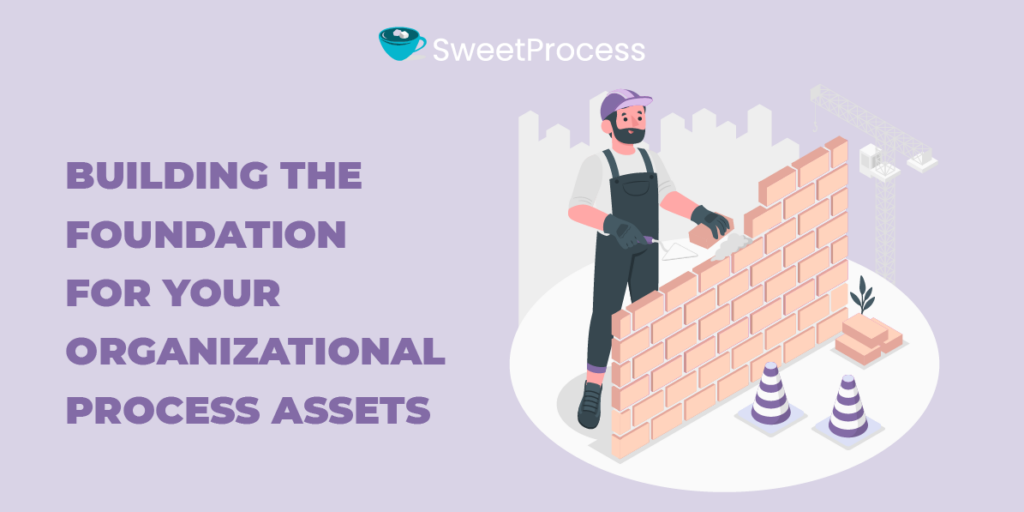
To build the foundation for your OPAs, you need procedures. In this section, we’ll examine why you need procedures and how to create them.
What Are Procedures?
Procedures are detailed step-by-step instructions that outline the specific actions, methods, and sequences to be followed in carrying out a particular task or process within an organization. They provide a structured framework for employees to execute tasks consistently, ensuring uniformity, efficiency, and adherence to established standards.
Why Are Procedures Important?
Your company needs procedures to clarify processes. Let’s evaluate some of the reasons why procedures are important.
● They boost consistency: If your organization is struggling with consistent task execution, you need procedures that provide a standardized approach. This way, you minimize errors and enhance the predictability of outcomes.
● Ensuring compliance: In industries subject to regulations and standards, procedures play a crucial role in ensuring compliance. They provide a clear roadmap for adhering to legal requirements, industry standards, and internal policies.
● Knowledge preservation: Procedures act as a repository of organizational knowledge, preserving best practices and lessons learned. They facilitate knowledge transfer, especially during employee onboarding or transitions.
● They boost efficiency: Well-defined procedures streamline processes, eliminating the need for employees to execute manual tasks. This efficiency saves time and optimizes resource utilization, contributing to overall organizational productivity.
When Do You Need Procedures?
As you create procedures, you should be efficient. Not all tasks need procedures. Therefore, you should only create them to simplify the company processes. Here are the times when you need procedures:
● Complex tasks: Procedures are essential when tasks involve multiple steps or require a specific sequence of actions. The more complex the task, the more critical it becomes to have a documented procedure.
● Processes with regulatory requirements: Procedures ensure that operations align with legal obligations. They also demonstrate an organization’s commitment to governance and accountability.
● Significant changes: Your company will also need procedures when you have key changes, like installing new software.
● Training and onboarding: You need procedures to onboard team members to a new process during training. They serve as a reference point for understanding task requirements.
How to Create Procedures
You need the right software and tools to create procedures. Here’s how to use SweetProcess to create company procedures:
● Log in to your SweetProcess account.
● Click the “Procedures” tab on the main dashboard.

● Click “Create Procedure” on the next tab.
● Add the procedure title on the next page.

● You can add details to your procedure and assign them to specific teams.
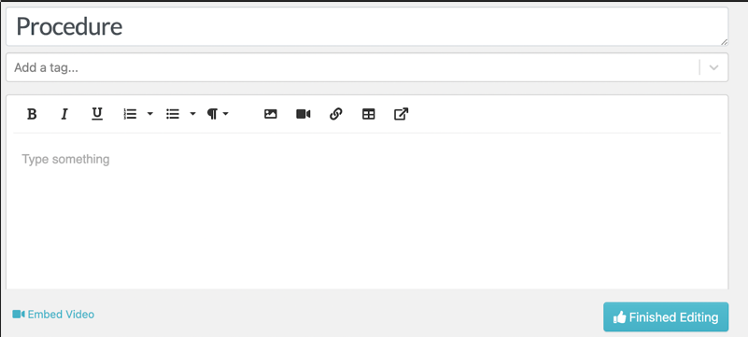
This section allows you to embed videos and images and add tags.
How to Document and Manage Procedures Using SweetProcess
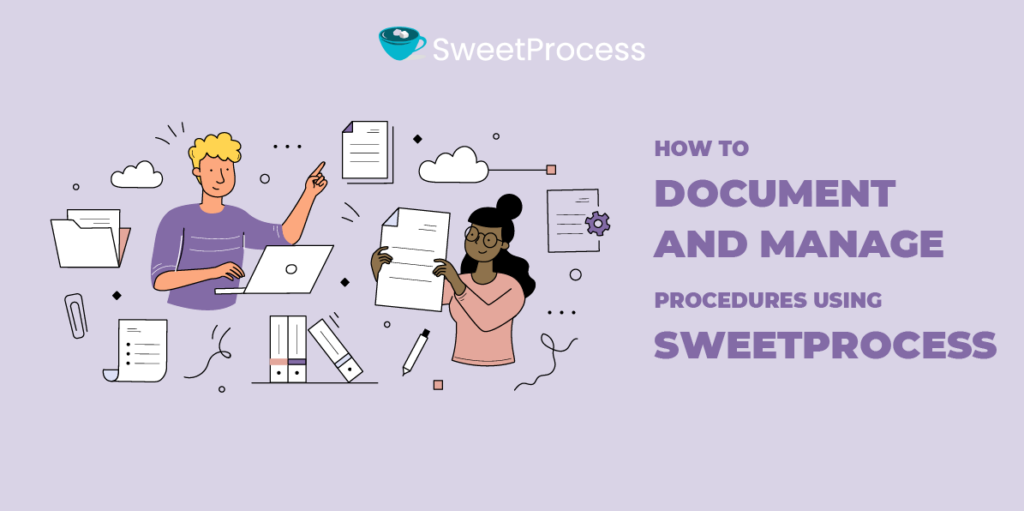
To document and manage your procedures on SweetProcess, you need to follow a format that includes the following:
● Title page
● Department, date, and identification number
● Purpose statement
● Definitions
● Step-by-step instructions
● Additional information such as roles, names, and signatures of the preparing team, and the table of contents.
As you document the procedures, you can use SweetProcess to create multiple documents for all company departments. Since all the procedures are stored in one place, your employees can find relevant project documents quickly.
All procedures are accessible from the SweetProcess dashboard. Use the search function to find the specific document using filters like tag, team, or recently edited. From here, you can edit and revise the procedures according to your business needs.
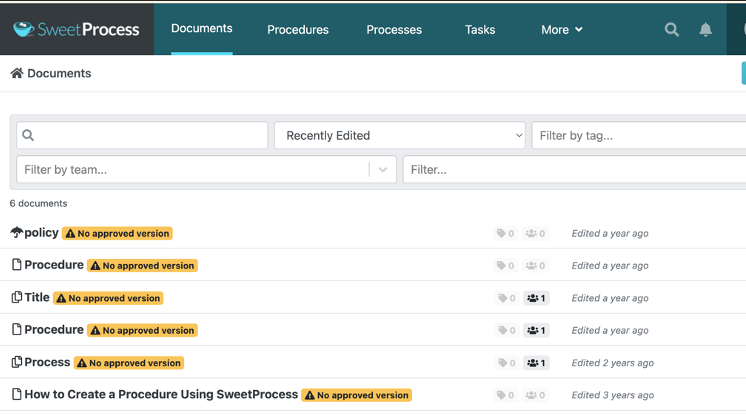
Jamie Ramsden, business intelligence and lean Six Sigma champion at Turkstra Lumber, is one of the business leaders using SweetProcess to document procedures. While the team had documented procedures on Excel sheets, they were inconsistent—there was so much back and forth. Therefore, Jamie had to look for an alternative SOP documentation tool.
Since they started using SweetProcess, they have had visual aids like flow charts to organize their tasks. They also had a centralized knowledge where team members could find all work-related information easily to avoid making mistakes. Ultimately, the company became more efficient.
Ready to transform your organizational workflows and boost efficiency? Dive into the power of SweetProcess with a 14-day free trial. Sign up now!
Processes: Leveraging Existing Procedures to Create OPAs That Stand the Test of Time
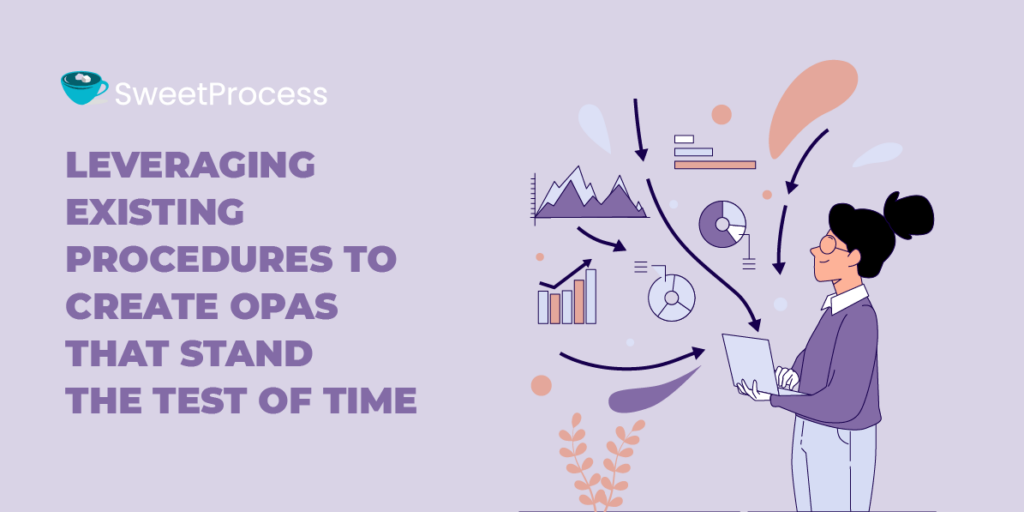
Your business also needs process documentation to be efficient. Here’s how to leverage these processes to create OPAs.
What Are Processes?
Processes are a systematic series of interconnected activities, tasks, or steps designed to achieve a specific organizational goal or outcome. Unlike procedures that focus on individual tasks, processes are broader and help coordinate various tasks to ensure the smooth flow of operations.
Why Are Processes Important?
Let’s examine the reasons you need processes:
● Boosts efficiency and optimization: Efficient processes streamline operations by eliminating redundancies and optimizing resource utilization. Organizations can enhance efficiency and overall performance by identifying bottlenecks and areas for improvement.
● Increases consistency: Processes contribute to consistency by ensuring that tasks are executed in a standardized manner. This consistency reduces errors and establishes a baseline for quality that can be replicated across various projects and initiatives.
● Adaptability to change: Well-defined processes enhance organizational adaptability. When procedures within a process are articulated, it becomes easier to adapt to changes in technology and market conditions without compromising efficiency.
● Simplified onboarding: When you have new employees, processes ensure the hires access information much faster. Once you show them what they need to do, they can quickly integrate and become productive.
When Do You Need Processes?
Your business needs processes for these functions:
● Scalability: As organizations grow, the need for well-defined processes becomes more pronounced. Processes provide a scalable framework that can accommodate increased complexity, ensuring that the organization can handle growth without sacrificing efficiency.
● Multiple functions: Processes are crucial when operations involve multiple functions, departments, or teams. They bind diverse tasks together, promoting collaboration and ensuring a seamless flow of activities across organizational boundaries.
● Continuous improvement: Processes are also essential for fostering a culture of continuous improvement. By documenting and analyzing processes, organizations can identify areas for enhancement and implement changes.
● Complex workflows: Processes become instrumental when workflows require collaboration between multiple stakeholders. They provide a roadmap for navigating complexity and ensure that each component contributes to the overall success.
How to Document Processes
If your primary goal is process management, here’s how to use SweetProcess to create one:
● Click on the “Processes” tab on the SweetProcess main menu.
● Select “Create Process.”

● On the next tab, add the title.
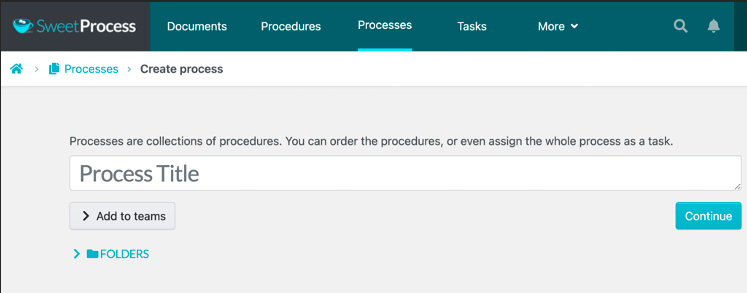
Add all the details you need about the specific process on the next tab. To make the process comprehensive, add images, tags, and videos.
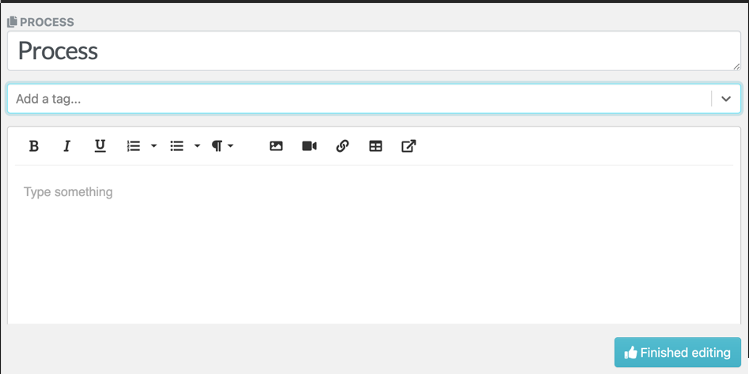
How to Create and Manage Processes Using SweetProcess
Managing processes is straightforward when you use the best process documentation software. When you open the dashboard, you can view all the processes. You can select the specific process, make edits, or add more content from here.

Process documentation has been an important feature for most companies using SweetProcess. One such business leader is Don Houk, the president of Next7 IT, who started using SweetProcess for import documentation. Although the company had processes, it heavily relied on Microsoft Word documents.
Because of this, the documents were hard to find and mixed up on different devices, affecting their workflow system. Employees also had a challenge executing their tasks. Since the switch to SweetProcess, the organization has tackled the knowledge gap issues. All company processes are documented in one location, making training and onboarding new hires easier.
Elevate your organization’s processes with SweetProcess. Take the first step toward streamlined workflows and enhanced collaboration. Sign up for your SweetProcess 14-day free trial now! No credit card is required.
Policies: Keeping Everyone on the Same Page Regarding Your Organizational Process Assets
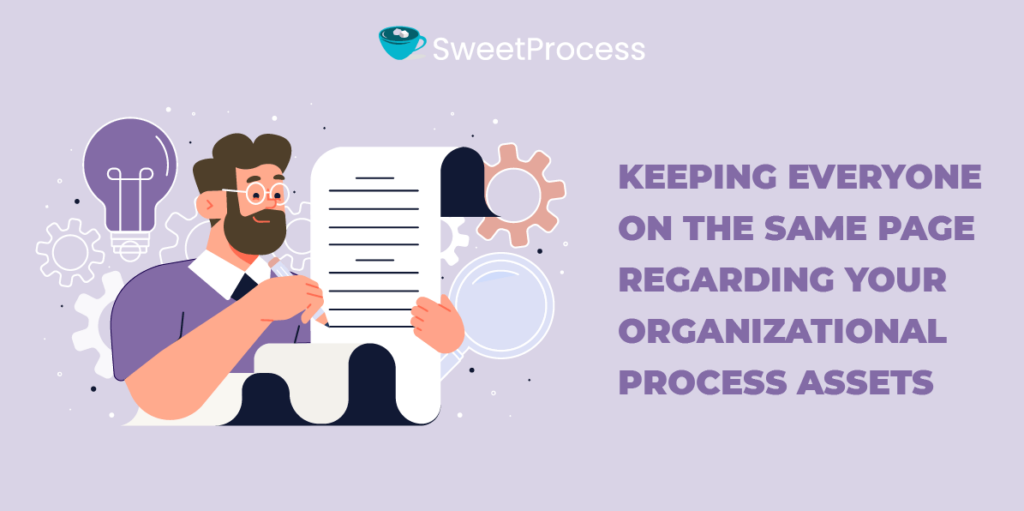
Well-crafted policies will help unlock your workforce’s potential and foster organizational effectiveness. Let’s examine how policies come in handy for your organizational process assets.
What Are Policies?
Policies are formalized sets of principles, rules, and guidelines that articulate the organization’s expectations, standards, and values. Writing a policy for your organization will provide a framework for decision-making, behavior, and the execution of tasks. With these policies, you can ensure everyone is aligned with the organization’s strategic objectives.
Why Are Policies Important?
Policies are an essential part of your organizational process assets. Here’s why you need them:
● To promote uniformity: Policies promote consistency by providing standardized guidelines. This uniformity helps maintain a cohesive organizational culture and reduces ambiguity in decision-making and behavior.
● Risk management: Well-defined policies contribute to effective risk management by establishing guidelines for identifying, assessing, and mitigating risks. You can use these policies when there are uncertainties and potential challenges.
● They boost governance and compliance: If your business has to adhere to legal requirements, industry standards, and ethical practices, policies mitigate risks associated with non-compliance. This is because they help establish governance structures within organizations.
When Do You Need Policies?
Your business needs policies on these occasions:
● Regulatory requirements: If your business operates in industries subject to regulations, policies serve as a roadmap for compliance, ensuring that operations align with legal and regulatory standards.
● Information security: In an era of digital information, policies are vital for securing sensitive data. Information security policies outline measures for data protection, access controls, and incident response, reducing the risk of data breaches.
● Ethical guidelines: Policies become crucial when organizations seek to maintain a specific ethical or cultural framework. They provide a foundation for employees to understand and embody the values that define the organization.
● Employee conduct: Policies are necessary for guiding employee conduct and behavior. They establish expectations for professionalism and interpersonal relationships within the workplace.
How to Write a Policy
Here’s how to create the policy on SweetProcess.
● Log in to your SweetProcess account.
● Select “More.”

● Click “Policies”

● On the next tab, select “Create Policy.”

● Add a policy title and include the details by ticking one of the boxes.
● Once done, select “Continue.”
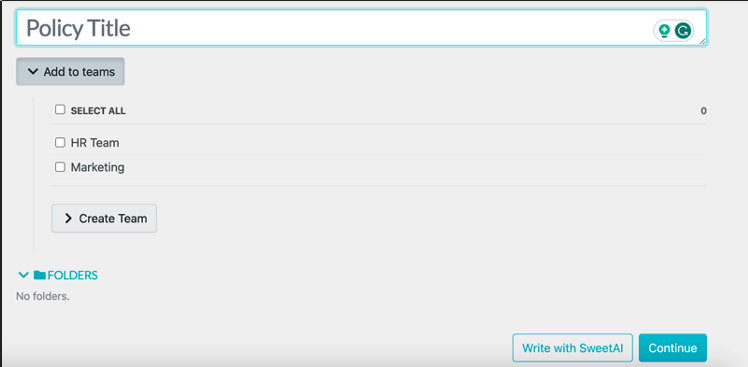
● You can also draft the policy and include the tags on the next page.

● Save the changes and add approval permissions to control access.
How to Create and Manage a Policy on SweetProcess
To effectively manage a policy, you need to consider application, communication, appraisal, maintenance, and reviewing of the process. As you create the policy, keep these factors in mind:
● Create well-thought-out policies that are precise and adhere to the law.
● Distribute the policy to all stakeholders.
● Train your employees on the regulations and risks of each policy.
● Conduct regular reviews and updates according to new industry changes.
If you have any changes, you can access all your policies from the main dashboard. Click the “Policies” tab on the main menu and select the one you need.
One of the business leaders who has benefited from this feature is Tom Vranas, the innovation and culture vice president at Everywhere Wireless. The company had policies in place; however, they were ineffective as the company grew. The manual system needed to meet the business needs; therefore, Tom had to find an alternative.
The search led him to SweetProcess. Since they started using this policy software, the company can now onboard new hires much more easily. Additionally, they can use the centralized knowledge base to ensure that all employees can access policies and the information they need to execute their jobs.
Ready to revolutionize the way you work? SweetProcess is your key to organized, efficient policies. Start your 14-day free trial today and witness the transformation in your organization!
Knowledge Bases: Educating Team Members on an Ongoing Basis
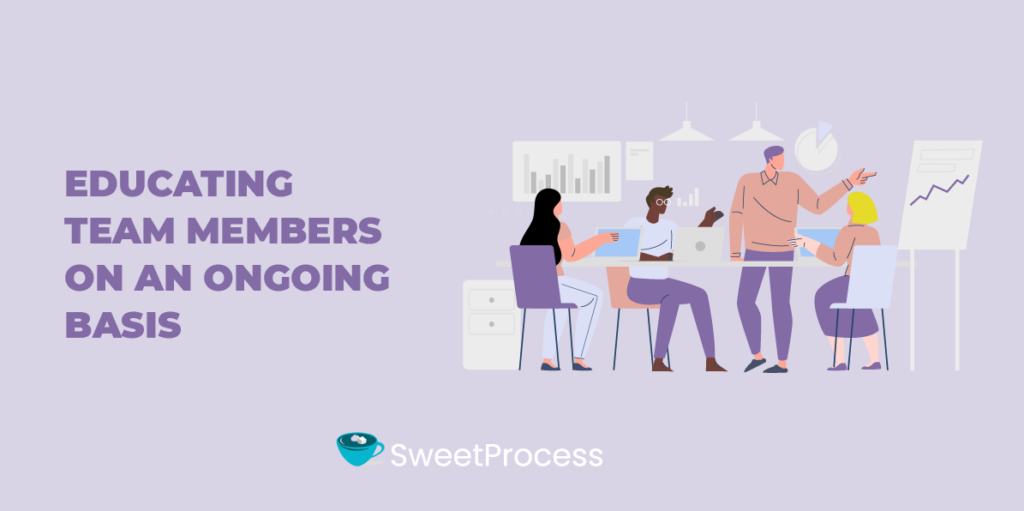
Is your business experiencing inefficiencies due to a knowledge gap? You need a centralized knowledge base to boost your operations. Let’s explore how a knowledge base is an important OPA.
What Are Knowledge Bases?
Knowledge bases are centralized repositories of information, insights, and resources that organizations use to capture, store, and disseminate knowledge within the company. They are a comprehensive source of expertise, providing a structured way to organize and access critical information related to processes, procedures, and best practices.
Additionally, they contain ready-to-use information. Therefore, your team can use this information to solve problems and execute tasks.
Why Are Knowledge Bases Important?
Here are the reasons why your company needs knowledge bases:
● Continuous learning: When you have knowledge bases, you can foster a culture of continuous learning within organizations. Your team members can access a wealth of information and adhere to the company’s best practices.
● Company efficiency: By centralizing information, knowledge bases enhance efficiency. Team members can quickly find the information they need, reducing the time spent searching for answers and enabling more focused and productive work.
● Employee onboarding and training: Once you hire new team members, you need these OPAs to onboard them. As a self-service training resource, employees can familiarize themselves with organizational processes at their own pace.
● Team collaboration: Knowledge bases facilitate collaboration by providing a shared platform for information exchange. Team members can contribute their expertise, share insights, and collaborate on solving challenges using a central resource.
How to Create a Knowledge Base
SweetProcess is a knowledge base software that allows you to provide information that everyone can access. Here’s how to use this tool.
● Log in to your SweetProcess account.
● Tap the “More” button on the main menu.
● Click “Knowledge Bases.”
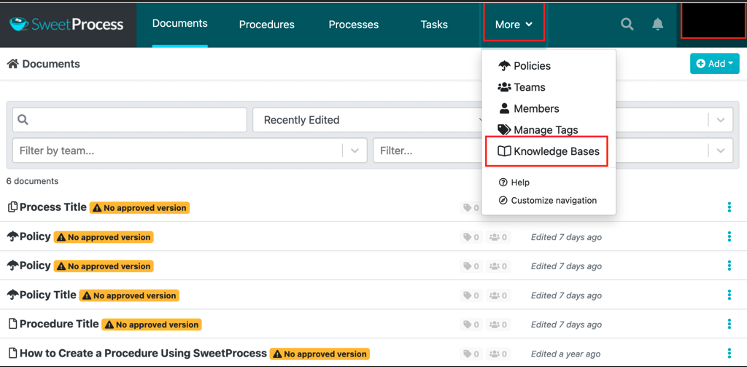
On the next tab, add a public URL that links to the knowledge base, category names, and control access to the information.
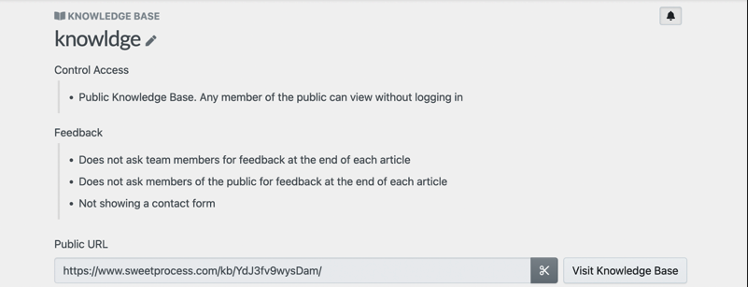
How to Create and Manage Knowledge Bases Using SweetProcess
Once you have the knowledge bases in place, you can manage them directly from the SweetProcess dashboard. Select the “Knowledge Bases” button to view all your repositories. Depending on your needs, you can edit or delete a knowledge base.

Because of these features, businesses have used SweetProcesses to centralize their assets. A good example is Stephanie Chavez, the chief marketing officer at Zen Media. The company had some form of documentation, but it was scattered, leading to disorganization. Due to a lack of a central knowledge base, employees could not execute their tasks when the individuals with tribal knowledge were unavailable.
Because of this, Stephanie knew she required a structured workflow. Since the adoption of SweetProcess, the team now has a centralized knowledge base for all employees to access, boosting uniformity.
Unleash the potential of your processes with SweetProcess. Sign up for a 14-day free trial and discover how our platform can centralize your knowledge base, saving you time and increasing productivity.
Best Practices for Managing Your Company’s Organizational Process Assets Effectively
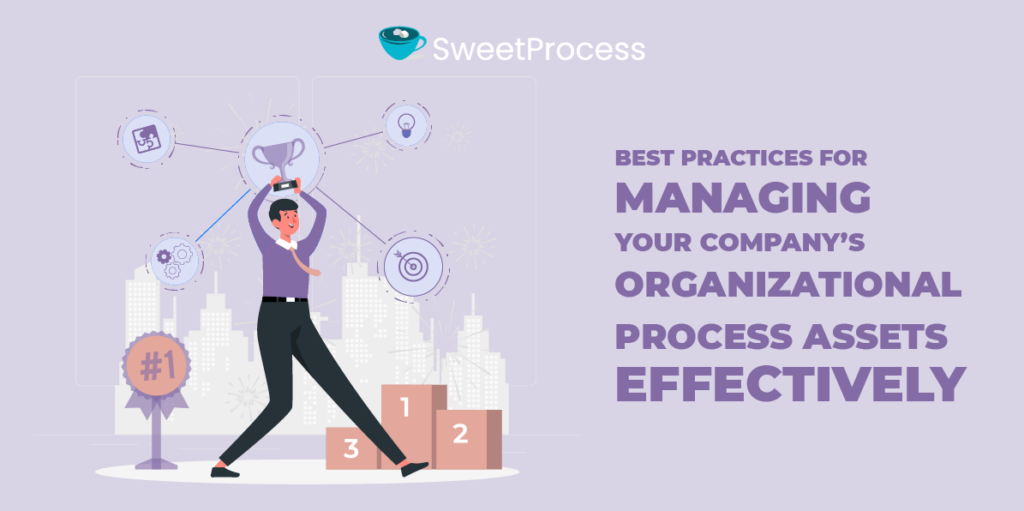
For your organization to develop effectively, you need to manage the company’s organization process assets. But how do you achieve this? Here are the best practices to guide you:
Establish Clear Guidelines and Policies
You can provide a foundation for managing OPAs effectively with clear guidelines and policies. They set expectations for how processes and procedures should be documented, updated, and accessed.
Additionally, guidelines ensure consistency, reduce ambiguity, and establish a framework for compliance with industry standards and regulatory requirements. For instance, you should implement templates and standardized formats for documenting processes, procedures, and other OPAs.
You should also regularly review these guidelines and make them easily accessible to all team members.
Use OPA Tools
OPA tools streamline the management of organizational assets, making it easier to create, update, and disseminate information. With dedicated tools, you can simplify the overall process of maintaining OPAs.
To achieve this, ensure that you choose the right tools that align with your organization’s needs and are user-friendly. Look for features such as version control, collaboration capabilities, and integration with other relevant systems. You also should provide comprehensive training for team members on how to use OPA tools effectively.
Prioritize Security
Security is important when managing OPAs because they often contain sensitive information. When you prioritize security, you can safeguard your organizational assets against data breaches and unauthorized access.
As a business leader, you should implement robust access controls to ensure that only authorized personnel can view or modify sensitive OPAs. Ensure that you restrict access based on roles and responsibilities within the organization.
Organizational Process Assets (OPA) vs. Enterprise Environmental Factors (EEF): How They Differ
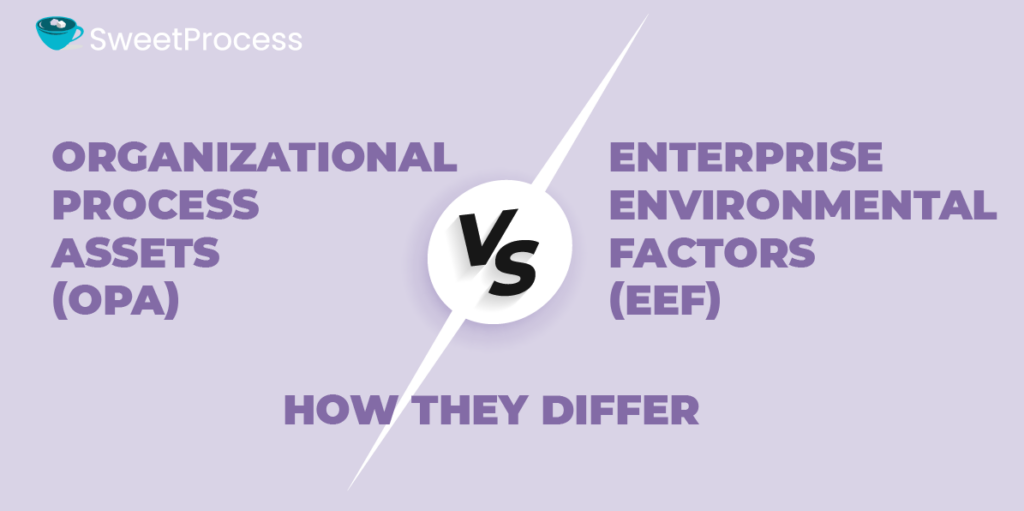
Organizational process assets (OPA) and enterprise environmental factors (EEF) are distinct elements in project management. Each of them plays a crucial role in your organization. Therefore, you need to understand how they differ to create more effective OPAs.
While OPAs are the internal accumulated knowledge, processes, and historical data within an organization specific to the organization, EEFs can be internal or external. EEFs are external influences that impact a project. They include conditions, cultures, and constraints outside the current project team and organization.
They shape the project environment and can influence decision-making and project outcomes.
Here are examples of OPAs:
● Previous project documentation: Lessons learned, project plans, and post-project evaluations.
● Processes and procedures: Standard operating procedures, workflow processes, and documented best practices.
● Templates and forms: Standardized templates for project documentation and reporting.
On the other hand, here are the examples of EEFs:
Internal EEFs:
● Organizational culture
● Risk tolerance
● Quality standards
● Project stakeholders
● Existing project management software
● Internal political conditions
External EEFs:
● Market conditions
● Consumer trends
● Government regulations
● Industry regulations
● External political conditions
● Financial considerations such as taxation and inflation
● Infrastructure
The difference between these two elements is that organizations have direct control over OPAs; therefore, they are actively managed and refined. On the other hand, EEFs are managed indirectly; the project team adapts to these external factors. Because of this, the project managers and business owners have limited options and choices with EEFs because they have no control over these external factors.
However, OPAs offer managers more options because they can be changed. They evolve over time as the organization learns and adapts. Understanding these distinctions is essential for effective project management. For your project management team to succeed, you should leverage internal assets and external influences.
Document and Manage Your Organizational Process Assets (OPAs) Using SweetProcess
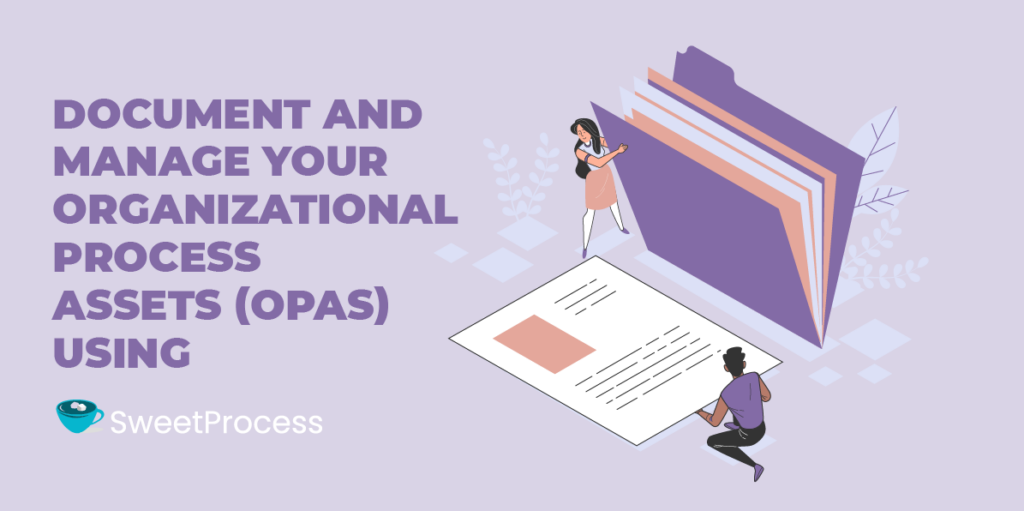
Effective documentation and management of organizational process assets are essential for organizational success. You need a comprehensive tool that centralizes your knowledge. SweetProcess stands out as an efficient business tool.
With SweetProcess, you can simplify the task of creating, updating, and disseminating OPAs. Its user-friendly interface allows for the seamless documentation of procedures, processes, and policies, ensuring that your team has easy access to critical information. You can access features such as standardized templates and collaborative features, making the management of OPAs an effortless experience.
Don’t miss the opportunity to transform your organizational workflows. Sign up for a 14-day free trial of SweetProcess today and elevate your processes. No credit card is required!
